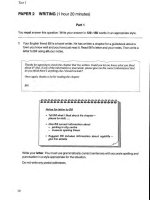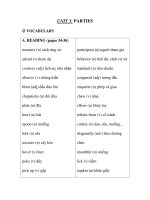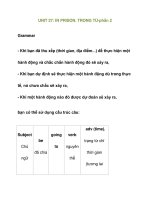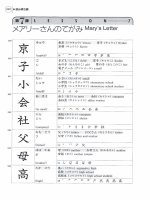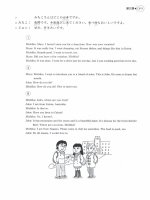genki 1 an integrated course in elementary japanese1 phần 2 potx
Bạn đang xem bản rút gọn của tài liệu. Xem và tải ngay bản đầy đủ của tài liệu tại đây (4.58 MB, 34 trang )
ADDITIONAL
VOCABULARY
Countries
Ameri
ka
lgirisu
Oosutoraria
Kankoku
Sueeden
Chuugoku
kagaku
ajiaken
kyuu
keezai
ko kusaikan
kee
kon
pyuutaa
jinruigaku
seeji
bijinesu
bungaku
rekishi
kaishain
kookoasee
shufu
daigakuinsee
daigakusee
bengoshi
o
kaasan
otoosan
oneesan
oniisan
irnooto
otooto
US-A.
Britain
Australia
Korea
Sweden
China
science
Asian
studies
economics
international.
relations
computer
anthropoIogy
pslitics
business
literature
history
job;
work;
occupation
doctor
office
worker
high
school
student
housewife
graduate
student
college
student
lawyer
mother
father
older
sister
older
brather
younger
sister
younger
brother
"It is
12:30."
"I
am a student."
"My
major is the Japanese language." These sentences
will
all
be translated into Japanese using an appropriate noun
and
the
word
desu.
@
9
I=
U
1.3
A/
TT0
(It)
is
half past twelve.
Juuniji
han
desu.
$2
(
*L\T-FO
Gakusee
desu.
tc
C3X.
z*T-3-0
Nihongo
desu.
(I)
am
a
studat.
(My
major)
6
the Japa~lese language.
Note that none of these sentences has a "subject," like the "it,"
"I,"
and
"my
major"
found
in
their English counterparts. Sentences without subjects are
very
common
in
Japanese; Japanese speakers actually tend to omit subjects whenever
they
think
it is
clear to
the
listener
what
or
who they are referring to.
What
are
we
to
do,
then,
when
it
is
not
clear
what
is
being
talked about? To
make
explicit
what
we
are
talking about, we
can
say:
t3
b=
G3h
Z*TT,
is
the
Japalaese kanguage.
wa
nihongo
desu.
Where
stands for the
thing
that
is
talked about, or the "topic," which
is
later
in
the sentence identified
as
nihowo.
For
example,
+&XI
SI
h,
4.3
it
t
3
h/
:*TTa
(My)
major
ds
the
Japanese langwzge.
Senrnon
wa nihongo
desu.
Similarly,
one
can
use
the pattern
X
wa
Y
desu
to
identify a person or a
thing
X
as
item
Y.
ti
It-
bk
Lt2
X-
-
+AT?,
I
am
Sue
Kim.
Watashi
wa
Suu Kimu desu.
93
LfiS"I3
*L*~\TTo
Yarnashita
san
wa
sensee
desu.
nA
96.
$7') 3LlA
7%1)3FJ13'b-c Fo
Mearii
san
wa
arnerikajin
desu.
Mr.
Yawhifa
ik
a
teacher.
Mary
is
an
American.
Wa
is
a
member
of
the
class
of
words
called
"particles."
So
is
the
word
lzo,
which
we
will
turn
to
later
in
this
lesson.
Particles
attach
themselves
to
phrases
and
indicate
how
the
phrases
relate
to
the
rest
of
the
sentence.
Note
also
that
nouns
like
gakwee
and
sesee
in the
above
examples
stand
alone,
dike
their
English
translations
"student"
and
"teacher,"
which
are
preceded
by
"a."
In
Japanese,
there
is
no
item
that
corresponds to
"a,"
nor
is
there
any
item
that
corresponds
to
the
plural
"-s"
at
the
end
of
a
noun-
Without
background
situations,
a
sentence
Iike
gakusee
desu
is
therefore
ambiguous
between
the
singular
and
the
plural
interpretations;
it
rnay
mean
"We
are/you
adthey
are
students,"
as
well
as
"I
am/you
are/she
is
a
student."
It
is
very
easy
to
form
questions
in
Japanese.
Basically,
all
you
need
to
do
is
add
ka
at
the
end
of
a
statement.
9
a
=,PSf(
*L~TT,
Ryuugakusee
desu.
(1
am)
an
iatemtGmnl
sturEenf-
9
@
3
5:
<
-@LYF&~'
Ryuugakusee
desu
ka.
(Are
you)
aH
i~tematio~al
student?
The
above
sentence,
Ryzcugakusee
desu
ka,
is
a
"yes/noW
question.
Question
sentences
may
also
contain
a
"question
word"
like
nun2
(what).
In
this
Iesson,
we
learn
how
to
ask,
and
answer,
questions
using
the
following
question
words:
nun.;
(what
time),
namai
(how
old),
nannensee
(what
year
in
school).
Note.
carefully
that
the
order
of
words
in
a
sentence
may
be
quite
different
from
what
you
find
in
your
language.
*h%
&la
Q'a'hTT-h~,
Senmon
wa
nan
desu
ka.
What
is
your
mior?
(+i?hS,&Ll)
;Z~\Z*TT,
(Senmon
wa)
eego
desu.
(My
major)
is
Eytglish.
'It
is
not
customary
to
write
a
question
mark
at
the
end
of
a
question
sentence
in
Japanese.
'The
Japanese
question
word
for
"what"
has
kvo
pronunciations:
=an
and
naai.
Naa
is
used
immediate-
ly
before
dmu
or
before
a
"counter"
like
ji
(o'clock).
The
other
form,
mmi,
is
used
before
a
particle.
Nani
is
also
used
in
the
combination
nanl;jin
(person
of
what
nationality).
2
fa'X/L*TTha,
Ima
nanji
desu
ka.
What
time
is
it
now?
97'.j-3ctli
Qx/%~~TT75~,
Mearii
san
wa
nansai
desu
ka.
How
old
are
you,
Mary?
QPthk*~
h~-p;tra.
N
annensee
desu
ka.
What
year
are
yo=
in
college?
(bw
{
CTTO
([ma)
kuji
desu.
It
is
nilae
o'clock
C:'rgj
4rp3
9\TT,
Juukyuusai
desu.
I'm
nineitem
years
old.
bchk*~\T-$-,
Ninensee
desu.
T&b
tfA
2"
9
t3
3
&TT75*,
Denwa
bangoo
wa
I
a6a7343~~,
nan
desu
ka.
lchi
hachi
roku
no
nana
san
yon
san
desu.
W7uat
ii
your
Eekpkose
amber?
It
is
186-7343.
No
is
a
particle
that
connects
two
nouns.
The
phrase
Toozai
daigaku
nu
gakusee
means
"(a)
student
at
Tozai
University."
The
second
noun
gukmes
provides
the
main
idea"
(being
a
student)
and
the
first
one
T~ozai
daigdku
makes
it
more
specific
(not
a
high
school,
but
a
college
student).
No
is
very
versatile.
In
the
first
example
below,
it
acts
like
the
possessive
("x's")
in
English,
but
that
is not
the
only
role
no
can
play.
See
how
it
connects
two
nouns
in
the
following
examples.
frl-fkSha
TLblXLt"?
Tukeshi's
phone
number
Takeshi san
no
denwa bangoo
f3\75${
a,
*~L*L\
daigaku
no
sensee
it
l3h
r"n
$75."
(
*L\
nihongo
no
gakusee
l=i3L,Ql
fsb~&z
{
nihon
no
daigaku
a
college
profasor
a
student
of
fhe
Japanese
lamuage
@college
i~
Japan
Observe
that
in
the
first
two
examples,
the English
and
Japanese
words
are
arranged
in
the
same
order,
while
in
the
last
two,
they
are
in
the
opposite
order.
Japanese
seems
to
be
more
consistent
in
arranging
ideas
here;
the
main
idea always
comes
at
the
end,
with
any
further
description
placed
before
it.
3Here
is
what
we
mean
by
the
"main
idea."
In
the
phrase
Tukeshi san
m
dmwa
Bangoo
(Takeshi's
phone
number),
the
noun
&wa
bawgoo
(phone
number)
is
the main
idea,
in
the
sense
that
if
something
is
Takehi's
phone
number,
it
is
a
phone
number.
The
other
noun
Takeski
san
is
not
the
main
idea,
because
Takeshi's phone
number
is
not
Tak&.
noun,
03
noun,
T
t
main
idea
further
restriction
A
phrase
of
the
form
"noun1
m
noun?
acts
more
or
less
like
one
big
noun.
You
can put
it
wherever
you
can
put
a
noun,
as
in
the
following
example:
id
Z~O
-
+/v-tt~\l~~,
Takeshi
san
no
okaasan
wa
kookoo
no
sensee
desu.
Takeski's
mather
is
a
high
school
teacher.
Expression Notera
1
-
8Db
Ano
indicates
that
you
have
some
reservations
about
saying
what
you
are
going
to
say
next.
You
may
be worried
about
interrupting
some-
thing
someone
is
currently
doing,
or
soundkg
rude
and
impolite
for
asking
personal
questions,
for
example.
[3tl/ZZb
Both
Rai
and
ee
mean
"yes"
in
response
to
yes-no
questions.
Compared
to
hai,
ea
is
more
conversational
and
relaxed.
In
more
informal
situations,
ula
is
used.
Hai
is
also
used
to
respond
to
a
knock
at
the
door
or
to
the
calling
of
one's
name,
meaning
"Here,"
as
follows.
(Ee
cannot
be
replaced
in
this
case.)
T
A
f
Teacher:
7:
5
2
3
?
Mr.
Smith?
Sumisu
san?
Student:
M
tl,
Hwe.
H
ai
E3TTlj\b
Soo
desu
ka
acknowledges
that
you
have
understood
what
was
just
said.
"Is
that
so?"
or
"I
see."
Pronunciation
of
1%
b
The
particle
t;t.
is
pronounced
"wa,"
not
"ha."
It
should
be
written
with
ki.
All
other
instances
of
"
wa"
are
written
with
b.
bfc
L
@I
T
Z
3
&
37-8667TB,
-
Watashi
no
denwa
bangoo
wa
san
narra
no
hachi
roku
roku
nana
desu.
My
telephone
wuwber
ii
37-8667.
There
are
a
few
exceptions,
such
as
kow~~zkkim
(good
afternoon)
and
kmbomwta
(good
evening).
They
are
usually
written
with
5,
tv
tZ
'It;
-
i2
and
7-
h,if&g.
Plumbers
b
Many
number
words
have
more
than
one
pronunciation.
Refer
to
the
table
at
the
end
of
this
book
for
a
general
picture.
tf
5
13
-ED
and
are
both
commonly
used.
I
t~%,butpronouncedas
~IYI
inbs3&&
(oneminute)and
t1~2
tl
(one-year
old).
2
tZ
all
the
time-
When
you
&e
reading
out
each
digit
separately,
as
when
you
give
your
phone
number,
it
may
be
pronounced
with
a
lung
vowel,
as
tZl.1.
3
"dX,
all
the
time.
The
part
that
follows
it
may
change
shape,
as
in
3
A&&,
instead
of
3
A&&.
4
L
h,
is
the
most
basic,
but
fourth-year
student
is
k
;BaXi-Fth
and
four
o'clock
is
d;
U.
In
some
combinations
that
we
will
later
kam,
it
is
read
as
L
(as
in
'L.fi%?,
April).
The
part
that
folIows
this
number
may
hange
shape
'too,
as
in
k.
&&A.
5
2
all
the
time.
When
read
out
separately, it
may
be
pronounced
with
a
long
vowel,
as
c-'
3
.
6
?3
<
,
but
pronounced
as
5
9
in
5
9
&A.
7
Q
te
is
the
most
basic,
but
seven
o'clock
is
L
Ei
C.
8
t3
G
,
but
usually
pronounced
as
6%
-7
in
iA
d:-;,
&X.
and
$2
3
3
tl.
9
3
o
5
is
the
most
basic,
but
nine
o?clock
is
<
C.
10
L@4,
butpronouncedas
Cgq
in
Cv~&."X/and
U~935.1.
Giving
one's
telephone
number
b
The
particle
.pro
is
usually
placed
in
between
the
local
exchange
code
and
the
last
four
digits.
Therefore,
the
number
012-345-6789
is
zero
icki
xi,
saa
yon
go
no,
roku
nana
hachi
kyuu.
@hreLlb
The
word se~see
is
usually
reserved
for
describing
somebody
else's
occupation. Watashk
wa
same
desu
makes
sense,
but
may
sound
slightly arrogant, because
the
word
semee
actually
means
an
"honorable
master."
If
YOU
(or
a
member
of
your
family)
are
a
teacher,
and
if
you
want
to
be
really
modest,
you
can
use the
word
kyooshi
instead.
&hr
b
Sun
is
placed
after
a
name
as
a
generic
title.
It
goes
both
with
a
given
name
and a family
name.
Children
are
referred
to
as
chan
(and boys in
,.:.I
.
:'.
,
pa&culaf
as
kurr),
rather
than
as
sax.
Professors
and
doctors
are
usually
referred
to
with
the
title
sensee.
Sm
and
other
title
words are
never
used
in
reference
to
oneself.
Referring
to
the
person
yw
are
talking
to
b
The
word
for
"you,"
anaba,
is
not
very
commonly
used
in
Japanese.
Instead,
we
use
the
name
and
a
title
like sun
and
sensee
to
refer
to
the
person
you
are
talking
to.
Therefore,
a
sentence
like
"Ms.
Hart,
are
you
Swedish?"
should
be:
It
&
t
r6
i
fPb
I\-t.
SLEk
x~3-~YL~T~~~,
Haato
san
wa
sueedenjin
desu
ka.
It
d
k
7
L
iT/"
instead
of
I\-
b
3&,
&;fcf i3
~3z-r"YVh/T?h~~
Haato
sari,
anata
wa
sueedenjin
desu
ka.
Japanese
names
b
When
Japanese
give
their
name,
they
say
their
family
name
first
and
given
name
last.
Usually,
they don't
have
middle
names.
When
they
introduce
themselves,
they
often
say
only
their
family
name.
Here
are
some
typical
Japanese
names.
Family
name
St?
Satoo
TT-3
Suzuki
fz
$1
12 L
Takahashi
blk-5
Itoo
Given
name
Men
Women
v5t
w4
r
Hiroshi
Yuuko
~1%
4
4
lchiroo
i?;tXI
c
Kenji
m.5
3
Yuuki
2
341.4
Masahiro
&("a
Megumi
BkSr
Kyooko
(Numbers)
ii
Q
h
-F~/+LL\
zero
ree
3XI
san
k
k/L/(1)
yon
shi
(yo)
?-*
C
go
G
{
roku
QQ/L%
nana
shichi
1.3
G
hachi
t"rg
j
L~S;
juuichi
Uqji:
juuni
L*@j
3tL
juusan
L"r95LAJL'@.9
L
juuyon
juushi
r*.p:*
juugo
r@eJ?d
juuroku
t"@3QP,./L'@?
LG
juunana
juushichi
t"*.s",&
juuhachi
Ct9-j
3@?/'C@?
t
juulcyuu
juuku
Izrt-P?
nijuu
3kL"@J5
sanjuu
LhU*?
yonjuu
L*L+@j
gojuu
&<C@3
rokujuu
QQC*?
nanajuu
!dGrt$?
hachijuu
3rs-iL"@3
kyuujuu
vs
{
hyaku
A.
Read
the
following
numbers.
@
(a)
5
(b)
9
(c)
7
(d)
I
(el
10
(f)
8
(9)
2
(R)
6
(i)
4
(j)
3
B.
Read
the
following
numbers.
@
(a)
45
(13)
83
(c)
I9
(d)
76
(el
52
(f)
100
(8138
(h)61
(i)24
(d97
C.
What
are
the
answers?
(a)
5+3
tb)
9+I
(el
3+4
(d)
6-6
(e)
IO+9
(f)
8-7
(9)
40-25
t=
U
niji
t&U
shichiji
ShC
sanji
tit%
t"
hachiji
@
l;f
(Time)
@
8
L>&
r
1
I2
z"
U
ichiji
yoji
goji
,
il:
?dl2
(C
t*=lt'
a
I
rokuji
kuji
juuji
t
E
I
i
:">
(TJ
@
L'@;l~%t'
C@?tcU
L\%
c
l3tL
juuichiji
juuniji
ichiji
han
A.
Look
at
the
following
pictures
and
answer
the
questions.
@
Example:
Q
:
&\3
tdhL"T'P$ko
ha
nanji
desu
ka.
A
:
~~GL't&X,TTO
Ichiji
han
desu.
B.
Answer
the
questions.
@
Example:
Q
:
Z
1
3hhTThao
Tookyoo
wa
irna
nanji
desu
ka.
A
:
r"*h
3
hL'-lvT,
Cozen
sanji
desu.
7
:
00
P.M.
7
Nnrr
Vnrlr
3
:
00~~~.
1
:
00
P.M.
5.
Bangkok
WL-
6.
Sydney
3.
Nairobi
4:OO
A.M.
9:
00
P.M.
1/
8.
Rio
de
Janeiro
3:OO
P,M.
@
Thral%hZj
(Telephone
Numbers)
A.
Read
the
following
people's
telephone
numbers.
@
Example:
f:
283-9547
+
E=Ga%$/v4,
$43
;1''1hQQ
YarnasRita
ni
hachj
san
no
kyuu
go
yon
nana
a,dj71\
1.
$79-
951-0326
Mearii
2.
fzit3
L
Takeshi
fi
3.
2-
Suu
?lIBY
4.
a/\'-
p
Robaato
B.
Pair
Work-Read
the
dialogue
below
with
your
partner.
@
A
:
TX/b
:*
3
63
Q
hTTdxo
Denwa
bangoo
wa
nan
desu
ka.
B
:
283-9547T$,
Ni
hachi
san
no
kyuu
go
yon
nana
desu.
A
:
283-9547TTh0
Ni
hachi
san
no
kyuu
go
yon
nana
desu
ne.
B
:
iitbl,
+?I
TTo
Hai,
soo
desu.
C.
Group
Work-Use
the
dialogue
above
and
ask
three
classmates
their
telephone
numbers.
name
telephone
number
Q
lzlzhzlD
A$<
(Ll
Translate
the
following
phrases
into
Japanese
using
(n
(no).
@
Example:
student of
the
Japanese
language
-+
dL
13
t"
Ql
21'
<
L
\
nihongo
no
gakusee
1.
my
teacher
3.
my
name
5.
Mary's
friend
7.
teacher
of
the
Japanese
language
2.
my
telephone
number
4.
Takeshi's
major
6.
student
of
the
University
of
London
8.
high
school
teacher
.
Look
at
the
chart
on
the
next
page
and
describe
each
person
using
the
cues
in
(a)
through
(e).
@
Takeshi
san
Suu
san
Robaato
san
Yamashita
sensee
(a)
nationality
&',
hIb
91
bj
7
i.
Ah')+
Example:
%
7'
'1
-3
b
+
%7J)-ShiA
7%
')fihL?T0-
Mearii
san
Mearii
san
wa
amerikajin desu.
(6)
year
in
school
g,
%,
?
1.
L+&?L.
Example
:
$7)
-3
3
%711-'Iht3
GZ&~+?L\TT,
Mearii
san
Mearii
san
wa
ninensee
desu.
(c)
age
ar,&
7~7
ah
1r\
Example:
%7"]-$h
+
97'1*$!~(3
c@?J
3@?
~L~TTO
Mearii san Mearii
san
wa
juukyuu
sai
desu.
(d)
school
&5h1Ih
wAlr3
&'lFta'
Example:
%71J-2tL
+
%7'11-3A13
79
'l*-?k.+~\$~<
Mearii
san
Mearii
san
wa
Arizona daigaku
no
75s
(
~&c\T-$-~
gakusee
desu.
(e)
major
hh9Ih
nb1ik
Example:
7
-A
+
$7
'1
-3
hC3
+XI$
CCC~~L~T?~
Mearii
san
Mearii
san
no
senmon
wa
nihongo
desu.
I
,4$"L;t;WL
I
(
Kirnura
Takerhi
I
Kim,
Sue
Nationality
Year
American
Age
School
Smith,
Robert
2nd
year
Major
British
(4
7'1
xu")
igirisujin
Japanese
19
U.
of
Arizona
4th
year
Korean
(6.A
z
{
U
A)
kankokujin
4th
year
Japanese
U.
of
London
3rd
year
22
Tozai
Univ.
business
zrr??
(r9;r.x)
biiinesu
20
Seoul
Univ.
history
(jk3
L)
rekishi
B.
Pair
Work-Ask
and
answer
questions
using
the
given
cues.
:brr
computer
it:&
(xx=-y-)
konovuutaa
9,dj
1i>
&ah?$.
Example
1:
97')-3h/79'IfiUL
Mearii
san
amerikajin
dh~qr*
&&qh-
Q
:
%r'J-L4,la
7%'ltJ~:'h'il"Tdx,
Mearii
san
wa
amerikajin
desu
ka.
L~:+-/,/%-L\
Yamashita
sensee
Japanese
,
Tozai
Univ.
(Japanese
teacher)
A
:22,
%-jTTo
Ee,
soo
desu.
w%r'Ii\
Example
2:
%
7'1
-3
h/Sh.h/v-@~\
Mearii
san
sannensee
hi,1r3
Q
:
$7'3
-5ktd:
3X,#3tL*b~T-T75*0
Mearii
san
wa
sannensee
desu
ka.
A
:
L\L\Z,
t=iklX/*~~T-$-*
lie, ninensee
desu.
Mearii
san
Arizona
daigaku
no
gakusee
*&'Jt'
2.
$7'1
$h/~%;4a&*L'
Mearii
san
ichinensee
3.
t2"z
Cj
LL/C=tShC&
Takeshi
san
nihonjin
4.
k't?
L
s
X//tct3/vtf~\itr'(
a
6"
*b\
Takeshi
san
Nihon
daigaku
no
gakrrsee
5.
k"rLtS,'L'@531.s3
2L'
Takeshi
san juukyuusai
T
i
+
;i
52-h
6.
X 3~/Z~.s-~2~~
Suu
san
sueedenjin
i
7.
X-3An
L/if~\3*."L\
(economics)
SUU
san
no
senrnon
keezai
Rohaato
san
no
senrnon
bijinesu
.3U&Z
9.
Up$-
b
?!X//&&h+3~\
Robaato
sari
yonensee
z,ifhL:
10.
UPT-~~X//~C~@~C~~?~L~
Robaato
san
nijuuissai
11.
93
tf~+hL+?~\/~=iahCL,
Yamashita
sensee
nihonjin
Yamashita
sensee
Hawai
daigaku
no
sensee
A.
Look
at
the
chart
below
and
describe
each
person
with
regard
to
(a)
and
(b).
1.
i5h*&3i&
okaasan
2.
~ECL\$X,
oniisan
(a)
occupation/school
adj'lts
Example:
f;Zi
3,4,
4
z'+I)-S/vO
SL
j
$/,,I2
;b'r\Lrb\/vcl,
otoosan
Mearii
san
no
otaosan
wa
kaishain
desu.
h.611'
Example:
+
%711-Sha
gr-5
)/Yc~
L/,L'ai~a~$Wf,
otoosan Mearii
san
no
otoosan
wa
yonjuuhassai
desu.
Mary's
host
family
sr.isx/
otoosan
(father)
3
h
okaasan
(mother)
Occupation/
School
t
*"L
shufu
&%L\
t
ek\k
kaishain
(works
for
a
company)
(housewife)
oniisan
lrnooto
?:L
@{
L
Zj
Lj-@h\
daigakuinsee
kookoosee
(graduate
(high
school
student)
student)
6.
Answer
the
questions
using
the
chart
above.
1.
S
Z
j
SXIt3
15a~\te~\X/To$75h,
Otoosan
wa
kaishain
desu
ka.
2.
sr
5.
2Ati
&F~~L\T-T-~*~
Otoosan
wa
nansai
desu
ka.
3.
SiP&
3
/"4a
*A+kc\'C'$is.,
Okaasan
wa
sensee
desu
ka.
4.
S+dj
3
5%
2
~hT-f-h*,
Okaasan
wa
nansai
desu
ka.
5.
i%
tc~>$.X,bd
hxL\
t
+WL:,-ebT~~,
Oniisan
wa
kaishain
desu
ka.
6.
sG=~\shEa
QkS~~T-Th',
Oniisan
wa
nansai
desu
ka.
7.
L\
Z,
j
Z
13
EL\$;
(
-ktkhTTbx,
lrnooto
wa
daigakusee
desu
ka.
8
L\%
Ij
Z
tA
~&SL\T+-?~~,
lrnooto
wa
nansai
desu
ka.
@
2
&@a
fib
b
I$
3
(Review
Exercises)
A.
Class
Activity-Ask
five
classmates
questions
and
fill
in
the
chart
below.
Example
questions:
;f;
3
5
2
ti
?
(What
is
your
name?)
Onarnae
wa?
*
Z
3
3
fz
hao
(Where
do
you
come
from?)
Doko
kara
kimashita
ka.
L
r'
Z
(occupation)
id
2
A
TTfi',
Shigoto
wa
nan
desu
ka.
fbCt/&lX,*~~Tj-~'.
Nannensee
desu
ka.
Q~3~q-j-$~~
Nansai
desu
ka.
*hit
hita
QLT-F;S~,
Senrnon
wa
nan
desu
ka.
B.
Self-introduction-Introduce
yourself
to
the
class.
Example:
Major,
etc.
Name
hiilL3
1;
X
z
IdCb3
LT0
%7Y
-
~h-
b
TTO
Hajimernashite.
A')
ZQ
Mearii
Haato
desu.
7
1)
9
jf:~h$z
<
5;
{
*L\T&
L~Z
Arizona
daigaku
no
gakusee
desu.
Ima
!~#~XI*L\T-~-,
*h/#,Al2
tcC3hz*Tj-,
ninensee
desu.
Senmon
wa
nihongo
desu.
Nationality
L:'~P
~~Q~$c\T.T,
Z"?F
."k5L(.
Juukyuusai
desu.
Doozo
yoroshiku.
Occupation/
School
Age
C.
Class
Activity-Ask
your
classmates
what
their
majors
are,
and
find
someone
who
has
the
following
major.
Example:
Q
:
*h%hla
fa'&T$hao
Senrnon wa
nan
desu
ka.
A
:
i:!3A
Z*TTO
Nihongo
desu.
name
1.
Japanese
2.
economics
3.
English
4.
history
5.
business
ITime
/
Age
Ti
me
hours
kh'f;
c
ichiji
3ht
sanji
L
r
yoji
:*
r
goji
t
4{C
rokuji
LGU
shichiji
13%
tJ
hachiji
(t"
kuji
C@?L\g3C
juuichiji
rug
j
CC~
juuniji
minutes
I
~h-3~::~
II
L'r9j~\-d."h
lPPun
juuippun
2
d=LaX,
12
Ct-Fji=LsA
nifun juunifun
3
3
,4, 2X/
13
b
3
StLwi:A
sanpun juusanpun
4
k
kli:h
14
C:'rg
3
k
ttYi:X/
yon
pun
Juuyonpun
5
<*,LA,
15
Y@5z*eiatL
gof
un
juugofun
6
57d:L
16
L"u9=75~+i."k
ro
p
pun juuroppun
7
322-X/
17
~~5.~~vi~A
nanafun juunanafun
8
td~d~tt/ldt:~LX,
18
C~?ld~wi~A/'
happun
hachifun
juuhappun
9
,4rgj,iaX,
C
@
9
li%visA,
kyuufun
juuhachifun
10
Ck#9e2L
19
La?
3q$wi-L
PPPU~
juukyuufun
20
tcc
:'7L,,j:tt
nijuppun
30
SL,12*7ei:A
sanjuppun
Age
~&SL\TT~*,/SL\{~~T-~~,
(Howoldareyou?)
Nansai desu
ka.
Oikutsu
desu
ka.
-The
counter
suffix
3
tb
is
used
to
indicate
"-years
old."
I
L>~$L\
5
~"SL\
9
$@j?w
issai
gosai kyuusai
2
icSc\
6
5(%>
10
C@73~1
nisai
rokusai jussai
3
SX/SL\
7
QQ?L\
[I
Ur9?~\-=,5~\
sansai
nanasai juuissai
4
kX/$b\
8
i3-33bh
20
t;f;7"r%*
yonsai
hassai
hatachi
'For
20
years
old,
t;t
fi
t;
~hatachil
is
usually
used,
although
i=
t'
@
7
3
I
(nil'msai)
can
be used.
a
Mary
goes
to
a
flea
market.
hbj?t\
1
%7l]-:
Mearii
TA3*tt,
rhia
L\(
h-r~h~,
Sumimasen.
Kore
wa
ikura
desu
ka.
2:
qjfita
LL~FALLT~-,
Mise
no
hito
Sore
wa
sanzen
en
desu.
#I
A
'I
rb
3
%~j-:
f~itr~~~~~~,
c
:'.(.
bj,
ha
z
u~\ta
L\
{
c;
~j h>,
Mearii
Takai
desu
ne.
Jaa,
ano tokee
wa
ikura
desu
ka.
4
A*a)'CTZ
:':
&&l2
3AettL*th
<
;2hTT,
Mise
no
hito
Are
wa
sanzengohyaku
en
desu.
&3
A
'1
1,
5
%7")-:
k
3
TTh.,
&$LS
f<h.~\T$&,
Mearii
Soo desu
ka.
Are
rno
takai
desu ne.
6
a*GT)p?f
:
*~~&T~~P
2hTTko
Mise
no
hito
Kore
wa
senhappyaku
en
desu
yo.
*&'It>
7
%7l]-:
EP&,
+c3ZIjt\2
(t:3b~~
Mearii
Jaa,
sono
tokee
o
kudasai.
A
man
finds
8
Lh2L't.W
Shiranai
hito
&&'lih
9
%Ti)-:
Mearii
wallet
on
the
ground.
rbtd
-f:ihcr,
3c\,iaTT
Kore
wa
dare no
saifu
desu
ka.
b?zLG3
$~\~iaT-j-~
Watashi
no
saifu
dew.
a&>
!I
h"
3
Z2"~*~\&
-j-,
Arigatoo
gozai
masu.
@
After
shopping,
Mary
goes
to
a
restaurant.
iLLZfz-?
811~~3
I
5'~-b
kX:
~\(,q
L+L\~-@~
%=ZL-~
Z"-j
Fo
Ueetoresu
I
rasshaimase.
Menyuu
o
doozo.
2
3
4
5
6
7
8
Words
That
*
r#t
*
.ih
*
a%jh
*
Yh
Z
a
*
%!a
*
z-0
*
ibf
t
Yr
*
7't'r$z
Food
*
~.L\LL\
Point
ko
re
sore
are
dore
kono
sono
a
no
dono
aso
ko
doko
dare
oishii
sakana
tonkatsu
niku
menyuu
yasai
enpitsu
kasa
kaban
kutsu
saif
u
jiinzu
jisho
jitensha
shinbun
teepu
tokee
toreenaa
this
one
that
one
that
one
(over
there)
which
one
this
.
. .
that
.
.
.
that
.
. .
(over
these)
which
. . .
over
there
where
who
delicious
fish
pork
cutlet
meat
menu
vegetable
pencil.
umbrella
bag
shoes
wallet
jeans
dictionary
bicycle
newspaper
tape
watch;
clack
sweat
shirt
*
Words
that
appear
in
the
dialogue
C
nooto
Pen
booshi
hon
notebook
pen
hat;
cap
book
Places
otearai
kissaten
gin
koo
toshokan
yuubinkyoku
restroom
cafe
bank
library
post
office
Counf
ries
Ameri
ka
Igirisu
Kankoku
Chuugoku
U.S.A.
Britain
Korea
China
keezai
economics
konpyuutaa
computer
bijinesu
business
rekishi
history
okaasan
mother
father
otoosan
Money
Mafters
*
L\(
1;
i
kura
how
much
.
.
.
yen
expensive
.
.
.
en
takai
Expressions
*
L\&-L+L\~*
irasshaimase
Welcome
(to
our
store)
*
(-
&
)
-j-
(
. . .
0)
onegaishimasu.
.
.
,
please.
*
(-2)
<
f<S&\
(
. .
.
O)
kuda~ai
Please
give
me
. .
.
*
t"~a&,
jaa
then
.
. .
;
if
that
is
the
case,
.
.
.
*
(-4)
?!9
-P
(
,
.
.
01
doozo
Here
it
is.
*
Z*?
%
doorno
Thank
you.
What
do
we
do
when
we
want
to
talk
about
things
that
we
do
not
know
the
names
of?
We
say
"this
thing,"
"that
one,"
and
so
forth-
In
Japanese,
we
use
kwe,
sore,
and
are.
t
&la
LX
(
b-c$-hS,
Kore
wa
ikura
desu
ka.
5Aeh2&T$,
Sore
wa
sanzen
en
desu.
Haw
much
is
this?
Tht
~
3,000
yen.
Kore
refers
to
a
thing
that
is
close
to
you,
the
speaker
("this
thing
here").
Sore
is
something
that
is
close
to the
person
you
are
talking
to
("that
thing
in
front
of
you"), and
are
refers
to
a
thing
that
is
neither
close
to
the
speaker
nor
the
listener ("that
one
over
there").
-:
x.
&+Ltd
kJ7L;LQl
+=/TTD
Are
wa
watashi
no
pen
desu.
*
A
ZjklA
bkta
~7Tj-,
Kore
wa watashi
no
pen
dew.
+h12
btz
L@
K~TT,
Sore
wa
watashi
no
pen
desu.
There
is
also
an
expression
dore
for
"which."
Here
we
wiIl
learn
to
use
dore
in
sentences
like:
rs"ktT-j-&~,
Dore
desu
ka.
Which
one
is
it
(that
you
are
talking
about)?
In
this
lesson,
we
will
not
explore
the
full
extent
to
which
the
word
dore
can
be
put
to
use,
because
there
is
a
slight
complication
with
question
words
like
dore,
Question
words
like
dwe
and
mni
cannot
be
followed
by
the
particle
wa.
Instead,
you
must
use
the
particle
ga
and
say:
-i
L
Z*&hz
&Qf=c?~
*>feTh',
~orega
anata
no
pen
desu
ka.
Which
me
is
yoiw
pen?
If
you want
ta
be
slightly
more
specific
than
kore,
sore,
and
are,
you
can
use
kmo,
smo,
and
am
together
with
a
nm.
(Note
here
that
the
re
series
must
always
stand
alone,
while
the
m
series
must
always
be
folbwed
by
a
noun.)
Thus,
if
you
know
that
the
item
in
your
hand
is
a
watch
Ctokee),
instead
of:
Zt-lAd
~k<
hTT&-o
Kore
wa
ikura
desu
ka.
you
can
say:
Z9Z&fW2
L\
(
hT-j-&~o
Kona
tokee
wa
ikura
desu
ka.
How
much
jS
this?
HOW
much
is
this
watch?
Similarly,
if
you
are
talking
about
a
watch
that
is
held
by
the
person
you
are
talking
to,
you
can
say:
+ar
t-$~lta
;x/-t~.~x/;?_~~~-j-~
Sono
toke
wa
sanzen
en
desu.
That
watch
is
3,000
yen-
And
if
the
watch
is
far
from
both
the
speaker
and
the
listener,
you
can
say:
&~r)Zd;f~\13
3&-85Lz*lP+
(
RLTT,
Ano
tokee
wa
sanzengohyaku
en
desu.
That watch
over
there
is
3,500
ym.
If
you
already
know
that
one
of
several
watches
is
3,500
yen
but
do
not
know
which,
you
can
say:
z*9rc3~\6~
~h~~/t+v+(;?-~/-r~fi~,
w~~~wu~c~~~~~uoY~vE~
Dono
tokee
ga
sanzengohyaku
en
desu
ka.
Since
dono
is
a
question
word,
just
like
dore
discussed
above,
we
cannot
use
the
particle
wa
with
it;
we
must
use
ga.
To
summarize:
zfi
(fa >
Z@
noun
(Ig )
close
to
the person
speaking
33%
(kt-)
503
noun
(la )
close
to
the person listening
(13~)
603
noun
(I$ )
far
from
both
people
(fj;-)
noun
(fi5 )
unknown
In
Lesson
1,
we
learned
how
to
say
things
like
Mean?
san
no
denwa
bangoo
(Mary's
phone
number)
and
Takeshi
san
no
okaasa~
(Takeshi's
mother).
We
now
learn
how
to
ask
who
something
belongs
to.
The
question
word
for
"who"
is
dare,
and
for
"whose,"
we
simply
add
the
particle
no.
z$%ta
iPr'#Ln
h*t%tlTThao
Kore
wa
dare
no
kaban
desu
ka.
Whose
bag
is
this?
+&la
ZsrLo
$*IfAtf,
Sore
wa
Suu
san
no
kaban
desu.
That
is
Sue's
bag.
We:
will
learn
just
one
more
ko-so-a-do
set
in
this
lessan:
koko,
soku,
usoh,
and
doko
are
words
for
places.
7-
LL
here,
near
w.w
?EZ
fhere,
mar
you
$;kZ
over
there
EZ
where
You
can
ask
far
direti~rms
by
saying:
TkS,2*A,
Ljp?ilF'A,41
(I3
Z*ZTT-~>~
Surnirnasen,
yuubinkyoku
wa
doko
desu
ka.
Exme
me,
where
is
fhe
post
office?
If
you
are
close
by,
you
can
point
toword
the
post
office
and
say:
(@jZP*h$a
{
(3)
&%tTT,
(Yuubinkyoku
wa)
asoko
desu.
(The
post
office
5,)
right
over
there.
We
will
learn
how
to
give
more
specific
directions in
Lesson
4.
In
Lesson
I,
we
learned
how
to
say
"Item
A
is
this,
item
B
is
that."
We
now
learn
how
to
say
"Item
A
is
this,
and
item
B
is
this,
too."
f=
CT
L
2
ua
it
tzx/c~,-c+"p,
Takeshi
san
wa
nihonjin
desu.
&%rsA%
i=~3ArLT-f0
Michiko
san
mr
nihonjin
desu.
Takahi
is
a
Japanese
person.
Mkhiko
is
Japanese,
&.
Note
that
these
two
sentences
are
almost
identical
in
shape-
This
is
natural,
as
they
both
claim
that
a
certain
person
is
Japanese.
The
second
sentence,
however,
is
different
from
the
first
in
that
we
do
not
find
the
particle
wa
in
it.
We
have
mo
instead.
Mo
is
a
particle
that
indicates
that
that
item,
too,
has
the
given
property.
One
thing
that
you
should
watch
out
for
is
exactly
where
the
particle
is
placed.
In
English,
the
word
"too"
can
be
placed
after
the
sentence
as
a
whole,
as
in
the
example
above.
Not
so
in
Japanese.
In
the
above
example,
mo
must
directly
follow
Michiko
san.
3
.
,
!A[
(
TF,
.
a
8
r
8
s
8.
A
is
X.
iBi
[xi
?To
,
m
A
*
BMisX.
+
4'
two
items
shared
property'
To
negate
a
statement
of
the
farm
X
wa
Y
desa,
where
Y
is
a
noun,
you
replace
ha&
2
with
ja
apdmsn.
Ji33E3Sttd
hP(it~\t"+&93-tS-ho
lk&Yamdais~ofastd~nf.
Yamada
san
wa
gakusee
ja
arimasen.
'We
cannot
use
nao
to
describe
a
situation
like
the
folIowing:
Our
friehd,
Pat,
has
dud
citizenship:
Pat
is
a
Japanese,
but
at
the
same
-time,
she
is
an
Americart
To
describe
the
second
half
of
this
situation,
we
cannot
say,
P~tto
m
~m&ajk
desas,
because
the
sentence
would
mean
that
Pat,
in
addition
to
sdmebady
that
has
been
mentioned,
is
an
American-
Neither
cari
we
say,
Pcaifu
wza
daibz
m
dem.
(Japanese
speakers
would
say,
Patto
ma
amdajivt
dma
nrkwases.)
'In
the
dialogues,
there
are
two
sentences
that
end
with
dm,
which
call
for
special
attention:
Are
m
tdad
dmtl
we
(That
one
too
is
expensive),
and
Oishii
desas
yo
(It
is
delicious).
These
sentences
cannot
be
negated
by
replacing
dm
with
ja
anhse~,
because
taka%'
and
okhii
are
not
nouns.
Are
n%o
takai
ju
~~nwbpett
and
oiskii
ja
adm
are
therefore
not
grammatical.
Instead,
me
would
have
to
say
f~kak
arimm
and
uishikzr
a?+mmm.
We
will
learn
about
the
conjugation
pattern
of
adjectives
in
Lesson
5.

